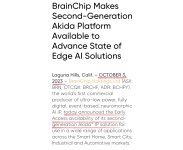Absence of evidence is not evidence of absence. There would be an NDA and it is possible that Meta insisted on secrecy about the collaboration.
I did not assume Meta was an EAP. I thought there was a reasonable inference to be made based on the available evidence.
If you didn’t assume Meta was an EAP, how did you think Meta engineers would have found out about the intricacies of TENNs around the same time EAP customers did? Customers that had explicitly paid for the privilege to get early access? That doesn’t make sense to me.
By the way, although Akida Gen 2 had been announced in March 2023 and the white paper on TENNs had been published in June, it appears that even for EAP customers, actual availability of the second generation of the Akida IP solution (which included TENNs) didn’t eventuate until October 2023, which happens to coincide with when Chris Jones had just started his new job at BrainChip.
Discover the revolutionary 2nd generation Akida platform by BrainChip, powering energy-efficient Edge AI devices with advanced neural network models.

brainchip.com
I have trouble understanding your 6 week window. It seems to be unsupported conjecture (…)
Your contention is that this means "on an almost daily basis (in the last 6 weeks) of my time at Meta, I would see new NNs."
No, that is not what I meant. He obviously would have seen new NNs on an almost daily basis throughout his eleven months at Meta
, not only in his last six weeks.
But if he had become “pretty excited” about TENNs while still working for Meta, would he even have bothered to spend his time on getting to know other neural networks or would he rather have focused all his energy and time on familiarising himself with TENNs and liasing with the software engineers at BrainChip?
If he had become “pretty excited” about TENNs sometime in 2023 already, would he really have said in late May 2024:
“So, about a year ago, uh, I was at Meta, I was in their AI Infrastructure Group, and on an almost daily basis I would see new neural network architectures.”
To me, it would only make sense if he had found out about TENNs roughly a year ago or later, and that brings me back to my six-week window: We can basically exclude he would have learnt about TENNs at his former workplace while already on gardening leave from Meta, agreed? So no later than mid-April then. And I doubt he would have referred to January or February 2023 as “about a year ago”.
But
@Iseki does have a good point here: Why would Meta have laid off one of their software engineers who by then would have already acquired in-depth knowledge of a disruptive and top-secret neural network that was going to give them a head start over competitors? There weren’t exactly dozens of global ML/AI experts around who were familiar with TENNs at the time.
Oh, and in case anyone pictured Chris Jones developing novel algorithms in Meta’s VR headset and smartglasses division or similar, that’s not what he actually did at Meta:
Another thing to ponder: If Meta was indeed behind an NDA, wouldn’t the reveal by Chris Jones that he had learned about TENNs
while at Meta constitute a breach of confidentiality? Correct me if I am wrong, but ex-employees cannot share trade secrets and confidential information without risking serious legal trouble, and Chris Jones could now be be taken to court for disclosing an NDA between Meta and BrainChip that the rest of the world wasn’t supposed to find out about…
Does that sound like someone on gardening leave, or someone with the weary or arrogant disdain of the "not-invented-here" attitude nurtured in a mega-corporation.
Chris jones was introduced to Brainchip, and they told him about TeNNs. So was the Akida marketing group going around talking to random gardeners in the off-chance they wished to lay out a lazy $5M for a licence?
No, of course not - what an absurd suggestion. Why did you have to turn this into ridicule?
As stated in my previous post, I’d venture a guess that he was introduced to BrainChip
while job-hunting,
so it was more likely him approaching BrainChip, not the other way round. If BrainChip staff had come to Menlo Park (Meta HQs) or Los Angeles (where CJ was based at the time) to instruct a group of Meta ML/AI engineers on TENNs (provided they were an EAP customer at the time, that is), why would Chris Jones say “they told
me about TENNs” instead of “they told
us about TENNs” - in the context of a job interview after June 9, 2023 (publication of the TENNs white paper) the use of the singular makes total sense, though.
So this is what I imagine happened: Either somebody in his professional or private network or a recruiter recommended BrainChip to him (a lot of people reached out to him in the comments after he had posted about having been laid off), and although he was sceptical at first (with exactly the mindset you are describing), he did give it a try, either out of curiosity (as someone he trusted had warmly recommended them to him) or because he hadn’t yet been successful in securing another job he deemed suitable. I presume that after having worked for Meta, he would have initially considered any remote or on-site positions other than with another Silicon Valley tech giant a painful career decline.
When you look at his mid-2023 LinkedIn posts/comments/reactions, quite a few of them revolve around tedious and nerve-racking experiences with Workday (a platform that allows companies to streamline their recruiting processes), and he also lists several certifications of online courses that he completed during those months post layoff and prior to starting at BrainChip. Does that sound like someone who was excited to have been “outplaced” from Meta to a disruptive technology company they had an NDA with and hence did not have to worry at all about who would be signing his paychecks from August 2023 onwards, or does it rather sound like someone on gardening leave forced to look for a new job, after losing the one he had been so proud of securing less than a year earlier?
It's about Attention and LSTM. You need to take the whole context into consideration.
I did, but I see a different context: He referred to his time at Meta during his introductory words on TENNs after he had given a brief overview of BrainChip for those unfamiliar with the company.
I believe that when Chris Jones gave his presentation at the 2024 Embedded Vision Summit, he wanted to convey to his audience that he had seen something truly extraordinary in TENNs. And what better way than to emphasise this uniqueness by casually mentioning that he used to work for Meta and had encountered new neural networks there on a regular basis, hence evoking credibility with his audience. Understandably, he did not mention the mass layoff at Meta that had subsequently affected him, even though an unfortunate job loss is of course nothing to be ashamed of.
After having been introduced to BrainChip at a later stage in the context of a job interview, our company surprised him positively, contrary to what he had expected, and the message he wanted to convey to his listeners was: Don’t underestimate us (like I did initially, coming from a mega-corporation) just because we are a small team and not a household name. We can easily compete with the big guys, as we have something unique to offer.
The more we discuss this, the more I am inclined towards the possibility of Meta being an EAP.
Funny you should say that, as the more we discuss this, I am more and more convinced of the opposite. I could be wrong of course, but so could you.
Yeah, but apart from Ford (which was never actually announced as an EAP, but safe to assume) which was not a good situation for the Company to have been put in and a major reason, why the Company now keeps its lips tightly zipped, the EAPs announced, have either been obscure, or relative small fry.
NASA is a huge name, but not really a business.
The Ford announcement in May 2020 preceded that of the introduction of the Early Access Program in June 2020, but yes, technically speaking, I’d consider Ford an EAP customer as well.
Mercedes can also be safely assumed, but not announced as an EAP (or I'm sure you would have dug it up).
Correct, there was never any ASX announcement about MB joining the EAP. However, Sean Hehir himself referred to them as an EAP customer on a slide in a September 2023 online investor presentation - as a Marquee EAP customer, to be precise, alongside Valeo, Vorago and NASA:
(from 27:33 min)
"Not all of BrainChip’s EAP customers have been disclosed to date"
Your statement infers, that most have, which would indicate you think we only have a handful..
I really don't think and hope that's not the case..
Well, if we are to believe Chris Jones - and unless this is yet another
typo on his presentation slide -
BrainChip currently has 10 customers (EAP, proof of concept and IP license) that have either licensed Akida IP (Renesas, Megachips) or once paid an undisclosed sum of money for the privilege of getting early access to our technology:
Correct me if I am wrong, but I believe that customer list should therefore read:
- Renesas
- Megachips
- Ford
- Mercedes
- Vorago
- NASA
- Valeo
- ISL
- ???
- ???
Which leaves us with only two mystery customers that fall into the category of either being an EAP customer or have used Akida technology to develop a proof of concept, as we would have found out about any additional IP licensees via price-sensitive ASX announcements.
Mercedes-Benz seems to match two categories at once, namely EAP customer AND “proof of concept” (EQXX) - I am a little confused as to why that distinction is being made, though.
It goes without saying those 10 customers are not indicative of the number of present engagements, NDAs and partnerships we have.
But Chris Jones learning details about TENNs before being laid-off at Meta could realistically only have happened if Meta was one of the two undisclosed EAP customers during Northern Hemisphere winter 2022/23 or early spring 2023.
However, in my eyes, it is much likelier that he was introduced to BrainChip and TENNs post-layoff, and I believe I have provided sufficient arguments to substantiate my point of view…

qz.com







